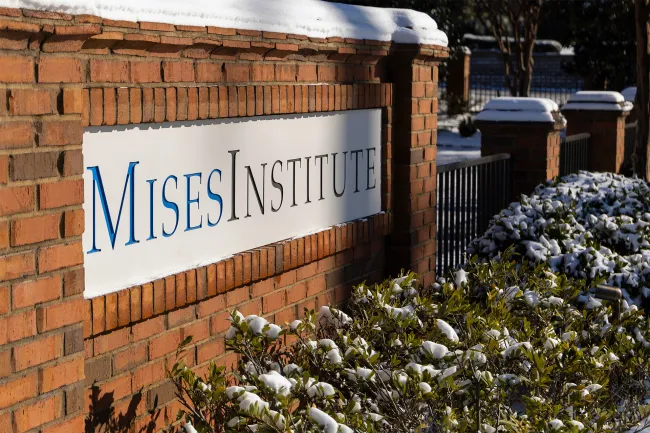According to the leader of the monetarist school, Milton Friedman, the key cause of business cycles are fluctuations in the growth rate of the money supply. Friedman held that in order to eliminate these cycles central bank policymakers should aim at a fixed growth rate of money supply. According to Friedman,
My choice at the moment would be a legislated rule instructing the monetary authority to achieve a specified rate of growth in the stock of money. For this purpose, I would define the stock of money as including currency outside commercial banks plus all deposits of commercial banks. I would specify that the Reserve System should see to it that the total stock of money so defined rises month by month, and indeed, so far as possible, day by day, at an annual rate of X per cent, where X is some number between 3 and 5. The precise definition of money adopted and the precise rate of growth chosen make far less difference than the definite choice of a particular definition and a particular rate of growth. (Dollars and Deficits, p. 193)
Friedman’s fixed growth money rule originated from the observation that fluctuations in the money growth rate are associated with fluctuations in economic activity. From this, Friedman has concluded that, in the absence of the money supply growth fluctuations, business cycles are also likely to be absent. However, a fixed money growth rule does not address the causes of business cycles. Causes cannot be ascertained by observations without providing a logical theoretical framework. According to Ludwig von Mises,
What we can “observe” is always only complex phenomena. What economic history, observation, or experience can tell us is facts like these: Over a definite period of the past the miner John in the coal mines of the X company in the village of Y earned p dollars for a working day of n hours. There is no way that would lead from the assemblage of such and similar data to any theory concerning the factors determining the height of wage rates.
What precipitates business cycles is not monetary growth beyond a fixed rate, but inflationary increases of money and credit. Monetary and credit inflation provides a platform for non-productive activities, which consume and add nothing to economic growth. In fact, inflation diverts savings and production toward non-wealth-generating activities, thus weakening the wealth-generating process.
Such a diversion occurs once early receivers of the newly-generated money and credit, inflated out of “thin air,” exchange their money for goods and services. This distorts the price and production structure, debases the value of the currency, and crowds out true wealth-generation. The increase of the prices of goods and services manifests this.
While the inflationary increase of money and credit temporarily stimulates non-productive activities, a fall in the growth rate of the money supply undermines these activities. The ability of non-productive activities to divert wealth from wealth-generators is curtailed. Since non-productive, bubble activities do not generate wealth, these activities cannot survive—at least to the same extent—without depending on inflation of the money supply. Therefore, a decrease of this monetary inflation sets in motion an economic downturn.
Friedman’s rules-based monetary policy cannot stop this emergence. Even a fixed money growth rule is still the artificial, inflationary expansion of money and credit, though at a fixed rate. It is also worth mentioning that even in a rules-based monetary policy—distinguished from a discretionary monetary policy—the rules are still established by the discretion of people, so it does not truly escape the problems of discretionary monetary policy. Hence, it weakens wealth-generators and undermines economic growth. We can conclude that Friedman’s monetary rule is simply another way of tampering with the economy and, hence, it cannot eliminate business cycles.
Gold Standard and Boom-Bust Cycles
Would the introduction of a gold standard eliminate business cycles? According to Friedman, what causes these cycles is fluctuations in the growth rate of money supply. Hence, from this perspective, under a gold standard, where there could be fluctuations in gold production, there can be fluctuations in the growth rate of money supply. Hence, according to Friedman, a gold standard will not eliminate business cycles.
It is true that an increase in gold production can and does generate fluctuations in the price and production structure. However, contrary to the artificial expansion of paper or digital money, an increase of gold is based on production and will not result in an exchange of nothing for something. It will not produce the diversion of wealth from wealth-producers towards non-wealth-generating activities.
Apart from providing the services of the medium of exchange, gold is also demanded for other valued uses. Therefore, when gold is exchanged for goods and services, wealth is exchanged for wealth. The supplier of gold—the gold mine—has increased the production of a useful commodity. Consequently, we also will not have the emergence of bubble activities. A wealth-producer, on account of the fact that he has produced something useful, can exchange it for other useful goods and services. On the gold standard, an increase in the growth rate of money (which is gold) will not artificially set in motion the emergence of false, bubble activities (i.e., an economic boom). Hence, a fall in the growth rate of money supply (gold) will not generate an economic bust.
The sudden disappearance of inflationary expansion of money and credit is the major, immediate cause of economic downturns. The artificial injection of money and credit out of “thin air” generates bubble activities while the sudden disappearance of this artificial money and credit destroys these bubble activities. On the gold standard, this cannot occur. On a pure gold standard, without the central bank, gold is money. Consequently, on the gold standard money cannot disappear since gold cannot disappear unless it is physically destroyed, which is an unlikely proposition. We can thus conclude that the gold standard, if not abused, is not conducive of boom-bust cycles.
Conclusions
Milton Friedman—the leader of the monetarist school of thought—observed that fluctuations in the growth rate of money supply could be an important factor behind business cycles. Hence, he suggested that central banks should aim at stabilizing the growth rate of money supply at some fixed percentage and keep it at this figure for an indefinite time. By maintaining the growth rate of money supply at a fixed percentage, Friedman held that the economy would follow a path of stable economic growth without business cycles. Friedman’s money rule, however, is still about artificially pumping money and, in this sense, it will generate the same effect as monetary inflation always does—boom-bust cycles.


